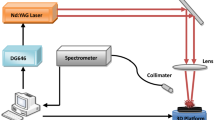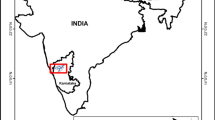Abstract
A novel method for developing a reliable data driven soft sensor to improve the prediction accuracy of sulfur content in hydrodesulfurization (HDS) process was proposed. Therefore, an integrated approach using support vector regression (SVR) based on wavelet transform (WT) and principal component analysis (PCA) was used. Experimental data from the HDS setup were employed to validate the proposed model. The results reveal that the integrated WT-PCA with SVR model was able to increase the prediction accuracy of SVR model. Implementation of the proposed model delivers the best satisfactory predicting performance (E AARE=0.058 and R 2=0.97) in comparison with SVR. The obtained results indicate that the proposed model is more reliable and more precise than the multiple linear regression (MLR), SVR and PCA-SVR.
Similar content being viewed by others
References
BOLF N, GALINEC G, BAKSA G T. Development of soft sensor for diesel fuel quality estimation [J]. Chemical Engineering Technology, 2010, 33: 405–413.
VAPNIK V N. The nature of statistical learning theory [M]. New York: Springer-Verlag, 1995: 93–110.
BASAK D, PAL S, PATRANABIS D C. Support vector regression [J]. Neural Information Processing, 2007, 11: 203–225.
NIU P, ZHANG W. Model of turbine optimal initial pressure under off-design operation based on SVR and GA [J]. Neurocomputing, 2012, 78: 64–71.
AMINGHAFARI M, CHEZE N, POGGI J. Multivariate denoising using wavelets and principal component analysis [J]. Journal of Computational Statistics and Data Analysis, 2006, 50: 2381–2398.
DIXON S J, BRERETON R G. Comparison of performance of five common classifiers represented as boundary methods: Euclidean distance to centroids, linear discriminant analysis, quadratic discriminant analysis, learning vector quantization and support vector machines, as dependent on data structure [J]. Chemometrics and Intelligent Laboratory Systems, 2009, 95: 1–17.
SON H, KIM C, KIM C. Hybrid principal component analysis and support vector machine model for predicting the cost performance of commercial building projects using pre-project planning variables [J]. Automation in Construction, 2012, 27: 60–66.
BABAOGLU I, FINDIK O, BAYRAK M. Effects of principle component analysis on assessment of coronary artery diseases using support vector machine [J]. Expert Systems with Applications, 2010, 37: 2182–2185.
ANTANASIJEVIC D Z, RISTIC M D, GRUJIC A A P, POCAJT V V. Forecasting GHG emissions using an optimized artificial neural network model based on correlation and principal component analysis [J]. International Journal of Greenhouse Gas Control, 2014, 20: 244–253.
JUHOS I, MAKRA L, TOTH B. Forecasting of traffic origin NO and NO2 concentrations by support vector machines and neural networks using principal component analysis [J]. Simulation Modelling Practice and Theory, 2008, 16: 1488–1502.
JOLLIFFE I T. Principal component analysis [M]. 2nd ed. Berlin: Springer, 2002.
SARBU C, POP H F. Principal component analysis versus fuzzy principal component analysis. A case study: The quality of danube water (1985–1996) [J]. Talanta, 2005, 65: 1215–1220.
WU J D, LIU C T. Finger-vein pattern identification using SVM and neural network technique [J]. Expert Systems with Applications, 2011, 38: 14284–14289.
LINDSAY I, SMITH A. A tutorial on principal components analysis [EB/OL]. [2014-04-22] http://kybele.psych.cornell.edu/~edelman/Psych-465-Spring-2003/PCA-tutorial 2002.
NARASIMHAN S, SHAH S L. Model identification and error covariance matrix estimation from noisy data using PCA [J]. Control Engineering Practice, 2008, 16: 146–155.
SHRESTHA S, KAZAMA F. Assessment of surface water quality using multivariate statistical techniques: a case study of the Fuji river basin, Japan [J]. Environmental Modelling and Software, 2007, 22: 464–475.
DAUBECHIES I. Ten lectures on wavelets [M]. Philadelphia, Pennsylvania: SLAM, 1992: 17–53.
HUANG H P, LUO KY. On-line wavelets filtering with application to linear dynamic data reconciliation [J]. Industrial & Engineering Chemistry Research, 2007, 46: 8746–8755.
BALAFAR M A. Review of noise reducing algorithms for brain MRI images [J]. International Journal on Technical and Physical Problems of Engineering, 2012, 4: 54–59.
JIANG T, CHEN B, HE X. Industrial application of wavelet transform to the on-line prediction of side draws qualities of crude unit [J]. Computers & Chemicals Engineering, 2000, 24: 507–512.
FLEMING F, WATZDORF R V, MARQUARDT W. Identification of trends in process measurements using the wavelet transforms [J]. Computers & Chemicals Engineering, 1998, 22: 491–496.
NOUNOU M, BAKSHI B R. On-line multiscale filtering of random and gross errors without process models [J]. AIChE Journal, 1999, 45(5): 1041–1058.
BENQLILOU C. Data reconciliation as a framework for chemical processes optimization and control [D]. Barcelona, Spain: Universitat Politecnica de Catalunya, 2004.
UNSER M, BLU T. Wavelet theory demystified, IEEE transaction on signal processing [J]. IEEE Transcations on Signal Processing 2003, 51(2), 470–483.
SI F, ROMERO C E, YA Z, XU Z, MOREY R L, LIEBOWITZ B N. Inferential sensor for on-line monitoring of ammonium bisulfate formation temperature in coal-fired power plants [J]. Fuel Processing Technology, 2009, 90: 56–66.
CRISTIANINI N, SHAWE-TAYLOR J. An introduction to support vector machines and other kernel-based learning methods [R]. Cambridge, UK: Cambridge University Press, 2000.
TAO X, ZHOU Y, WEI Q, YU G, CUI Q, LIU J, LIU T. Effect of morphology properties of NiW catalysts on hydrodesulfurization for individual sulfur compounds in fluid catalytic cracking diesel [J]. Fuel Processing Technology, 2014, 118: 200–207.
MEDINA E A, PAREDES J I P. Artificial neural network modeling techniques applied to the hydrodesulfurization process [J]. Mathematical and Computer Modelling, 2009, 49: 207–214.
WANG J, WU X, ZHANG C. Support vector machines based on K-means clustering for real-time business intelligence systems [J]. International Journal of Business Intelligence and Data Mining, 2005, 1(1): 54–64.
MOMMA M, BENNETT K P. A pattern search method for model selection of support vector regression [C]// Second SIAM International Conference on Data Mining, Arlington, USA: SIAM. 2002: 261–274.
Author information
Authors and Affiliations
Corresponding author
Rights and permissions
About this article
Cite this article
Shokri, S., Sadeghi, M.T., Marvast, M.A. et al. Soft sensor design for hydrodesulfurization process using support vector regression based on WT and PCA. J. Cent. South Univ. 22, 511–521 (2015). https://doi.org/10.1007/s11771-015-2550-6
Received:
Accepted:
Published:
Issue Date:
DOI: https://doi.org/10.1007/s11771-015-2550-6




